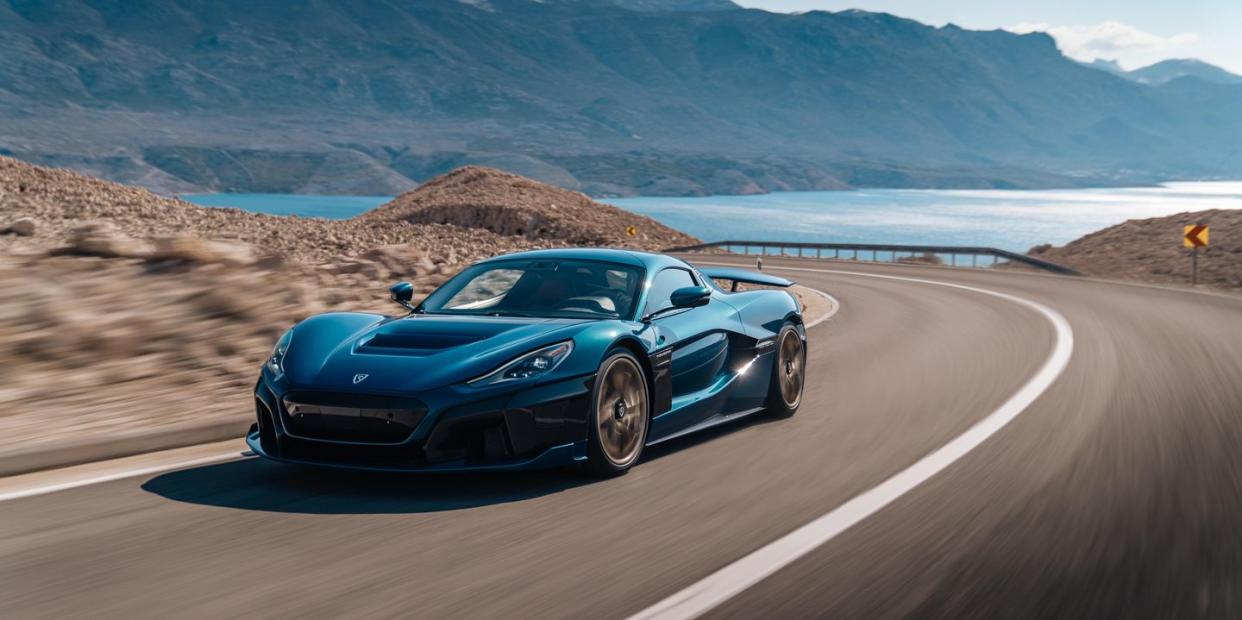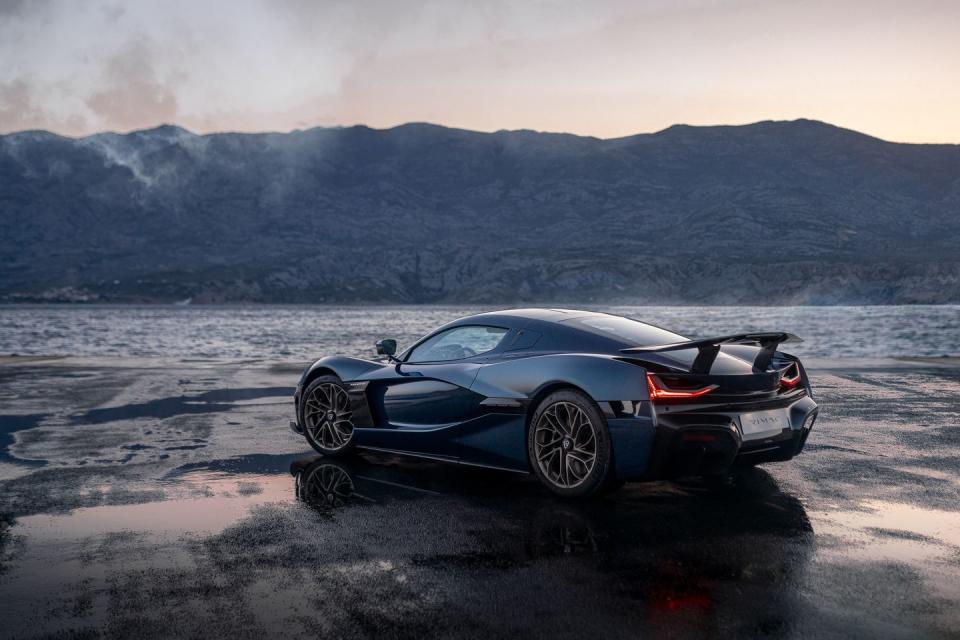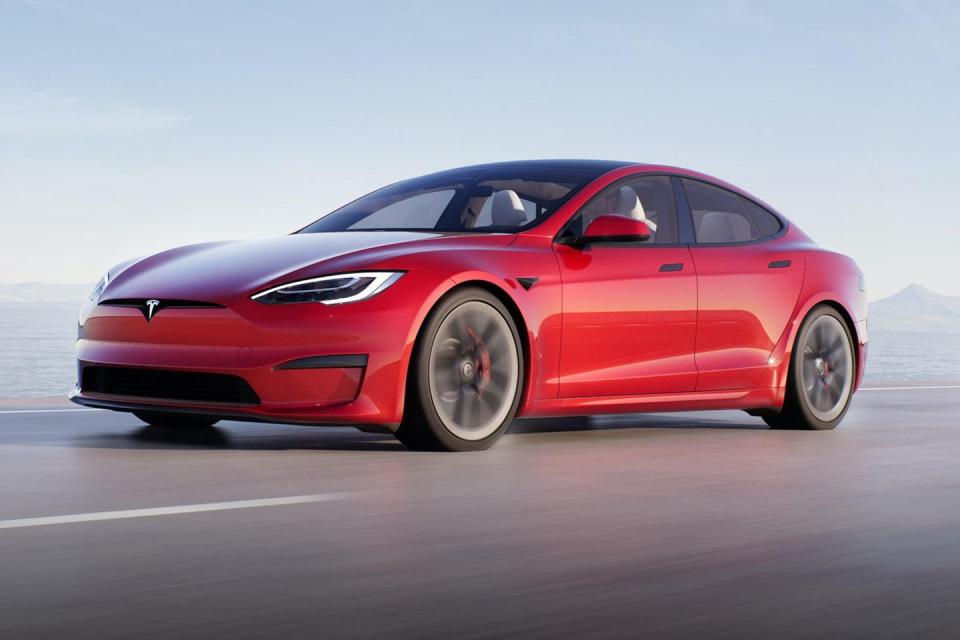These 3 Hypercars Prove There’s No Reason to Fear the Electric Future

- Oops!Something went wrong.Please try again later.
Electric hypercars mean the electric future will be fun, as evidenced by recent drives in Rimac, Tesla, and Porsche EVs.
The newest of the bunch, the Rimac puts out 1914 hp, does 0-60 mph in 1.85 seconds, and has a top speed is 258 mph—all while claiming a 340-mile range.
All we need is for performance to filter down to more affordable EVs.
Power and torque used to be pretty straightforward—there they were in your engine ready to make your car go forward. Not too long ago 300 hp was really something. Then it took 400 hp to get your attention. Then 500, and now—ho, ho, ho, now my friend, horsepower and torque are just going bat-poop crazy. The advent of electric hypercars has tossed all previous notions of “normal” performance out the driver’s side window, where they are being run over by passing traffic as you read this. Because electric power, which is far easier to adjust to your own evil ends, is now “on tap” as the magazines used to say, in amounts previously reserved for electric locomotives, rail guns, and rockets launching spacecraft. By simply cranking the amps up in exchange for range you can blast yourself down the road at speeds once thought possible only in video games.
I know this because I just drove a Rimac Nevera on the street, a Porsche Taycan on the track and I’ve even driven a couple Tesla Models S. Each one offered acceleration unmatched by any previous car any of us have driven, unless you drive in TF, FC, or TAFC in the NHRA.

Take the all-electric Rimac Nevera. With one electric motor for each of the car’s four wheels, the Nevera makes an utterly ridiculous 1914 hp. That’s roughly four times more than the mighty C8 Corvette you put your deposit down on a year and a half ago. Torque in the Rimac is a mighty 1741 lb-ft, again, almost four times more than your C8 Corvette and probably two or three times what your F-150 makes. Zero-to-60 comes up in a light-bending 1.85 seconds, the quarter mile in 8.6 seconds, and top speed is 258 mph, Rimac says, all numbers you’d previously have needed a degree in physics just to grasp. On top of that, Rimac claims a 340-mile range on the European WLTP cycle and a 19-minute recharge time from 0-80 percent from a 500-kW charger. Price is an entirely reasonable $2.4 million. Only drawback is that it seats only two, though maybe that’s not a drawback.

The far-more-practical Porsche Taycan EV meanwhile, still offers from 402 all-electric horsepower in the base model all the way up to 750 hp in the Taycan Turbo S, the latter which gets from 0-60 in 2.6 seconds. And all Taycans seat four with room for luggage to boot. Taycan prices range from $82,700 to $187,600.
The Tesla Model S Plaid also seats four but offers 1020 hp and a 0-60 time (with the right tires and the planets aligned) of 1.99 seconds. That model stickers for $129,990 but you can get into a base Model S Long Range for $89,990 and get 405 miles on a charge.

How can you complain about any of that? The point here is that even though the world seems to be transitioning from internal combustion to electric drive, you do not have to give up performance in the process. The only thing you may be missing is the roar of the engine, but it’s possible you could get over that. There are modern, well-equipped hypercars coming on the market, loaded with all the other luxury doilies customers demand nowadays, from USB charging ports to cupholders and all that infotainment connectivity. They don’t even squeak or rattle.
Let’s start with the Rimac Nevera, since it’s the newest and most exciting. The Nevera is a proud product of Croatia, built by the inspired and talented Mate Rimac and his merry band of engineers. Rimac first got interested in electric cars when he converted his BMW 325i to electric power. “Hey,” he thought at the time, “This is fun!” From that came the C_Two concept car shown at Geneva in 2018, and from the C_Two came the Nevera.
We got to drive one, not on a race track or even on a good mountain road, but on the somewhat crowded streets of West Los Angeles (you take what you can get). We started at the Rimac (and McLaren, Bugatti, and Rolls-Royce) dealership on Olympic Blvd. A company in LA called O’Gara Coach sells all the world’s great supercars, including even Koenigsegg and Pininfarina. What a place!

At first we rode along in the passenger seat with Rimac’s North American sales head driving. He was fearless, waiting for a hole in traffic then launching the Nevera into Never-Never Land. When I got behind the wheel and waited till all the traffic had cleared, I gave it a stab, too, and my life has never been the same. You have to reorganize your brain and all its sensors to grasp how quick and fast this thing is. None of us outside of those from the NHRA has ever driven anything like this. The acceleration is absolutely howlin’ stupid.
There’s a similar sense of shock and awe with the Teslas. I drove a Model S P100D a while back, a car that is short of the Model S Plaid’s performance but not by much. The P100D was the top of the Tesla performance pile back then, with a 0-60 time of 2.5 seconds and a quarter-mile time of 10.6. The Plaid now gets to 60 in less than two seconds, according to Tesla, with a quarter mile of 9.23 at 155. It’ll lap Laguna Seca in 1:30.3, which shows it has a good balance of performance and acceleration.
But so does the Porsche Taycan, in which I earlier this year spent the day hot-lapping the 1.3-mile track at the Porsche Experience Center just south of Los Angeles. My instructor was the same Michael Johnson who’d lead me around the PEC as I drove a series of GT3s last year. He was fast and following him made me—and could make you—fast, too. My Taycan was a 2020 Carrera White Metallic Turbo S sedan loaded up to $204,420. It had Porsche Dynamic Chassis Control Sport and rolled on bespoke Pirelli P Zero Elects measuring 265/35R-21 front and 305/30R-21 rear. Anyone trying to dismiss the Taycan as not as thrilling around a track as the GT3s I drove ought to sign up for the Taycan Turbo Experience at PEC. It’s only $600 and for that you get almost as many laps as you can handle. With Johnson leading the way, and Porsche Dynamic Chassis Control Sport managing the chassis, I was free to concentrate on the fastest line and the best braking points. It’s great to get an instructor like Johnson, who very quickly ascertains his students’ abilities and adjusts his driving accordingly. In our case, we hauled Kiester around that track out in the wilds of rural Carson, California.

“That was about as fast as I’ve ever gone in an electric car on this track,” Johnson said.
“Me too,” I gurgled.
Radio chatter from the pits had other instructors wondering what the heck we were doing out there.
“Qualifying,” I heard Johnson say.
Ha ha ha.
Yes, you miss the sound of a flat-six roaring and revving and the feel of matching revs as you enter corners, but for sheer thrill, an all-electric Taycan is every bit as fun as almost any other car.
Porsche just revealed the all-electric Mission R at the IAA Mobility in Munich two weeks ago, a sports car sized approximately the same as the current 718. While I haven’t driven it yet, I did also take a Taycan up my favorite mountain road and was likewise smitten. It gives you a stealthy anonymity as you bomb silently into corner after corner.
If the future is electric, I say bring it on. You have nothing to fear but fear itself, and the near-total lack of exhaust note.
Would you be inclined to buy an electric sports car if the performance was on par or topped the best gas-engined examples around? Share your thoughts in the comments below.

